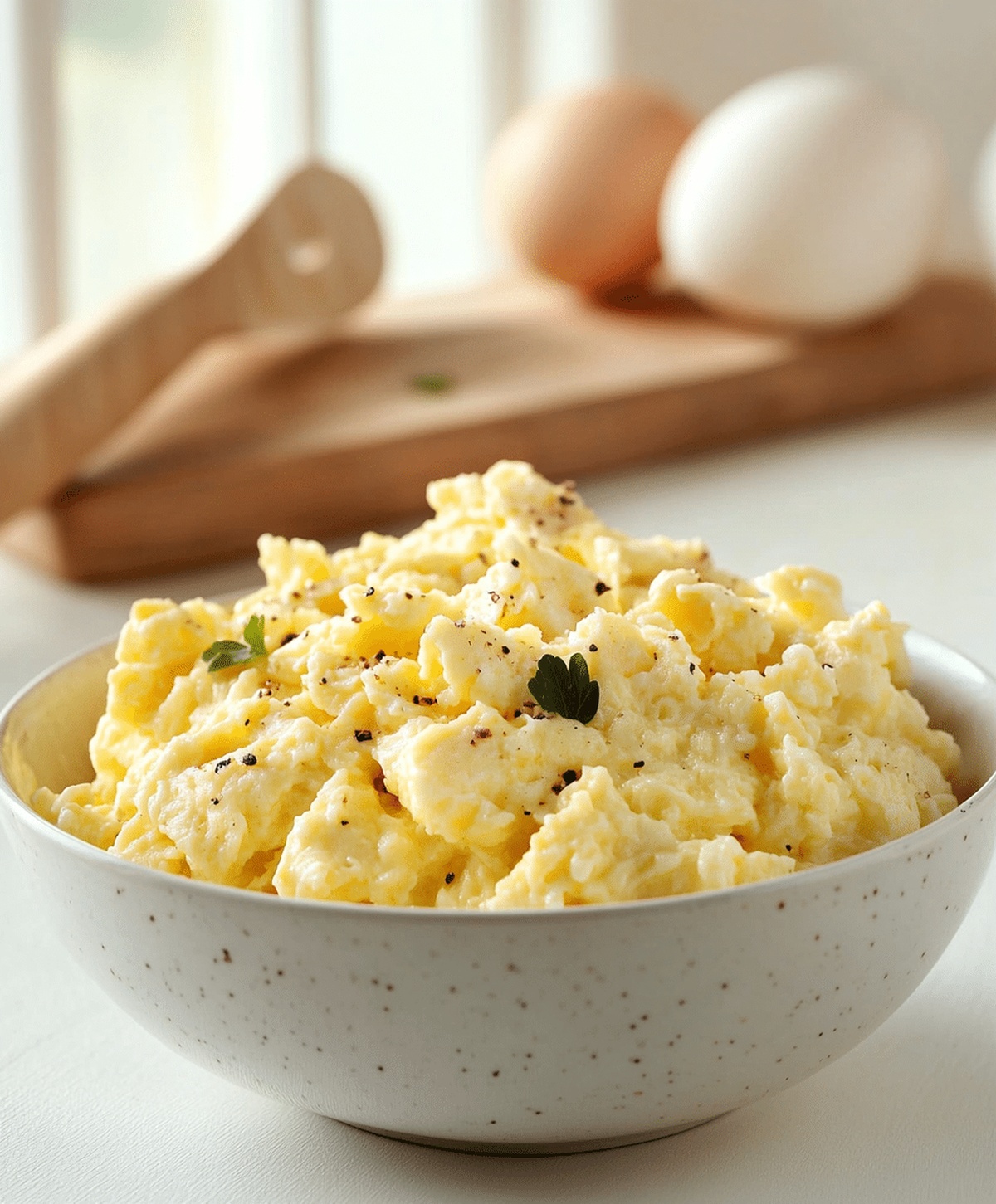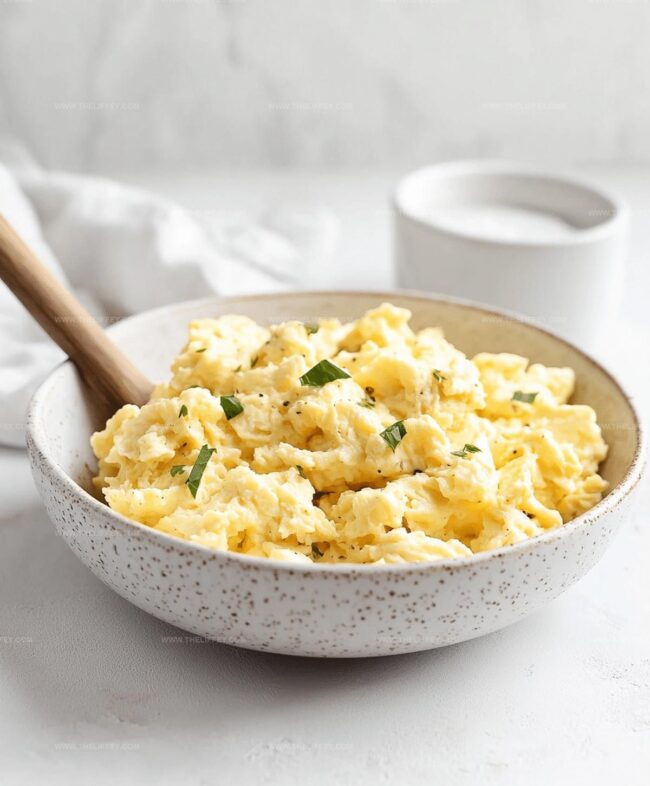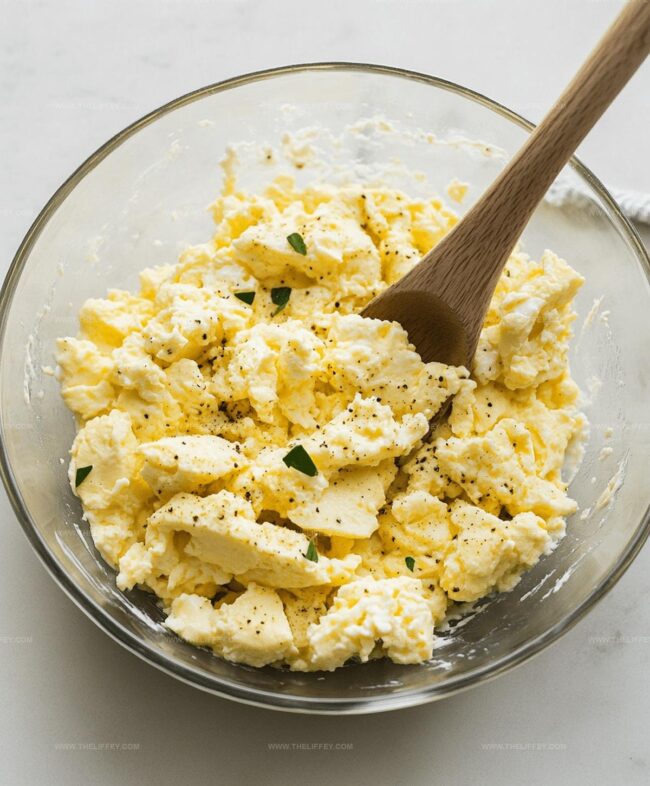Fluffy Creamy Cottage Cheese Scrambled Eggs Recipe to Savor
Whipping up a delightful cottage cheese scramble transforms ordinary breakfast into a protein-packed morning sensation.
Soft curds blend seamlessly with whisked eggs, creating a luxurious texture that melts in your mouth.
Nutritionists praise this unexpected combination for its high protein content and creamy consistency.
Chefs love how simple ingredients can produce such a satisfying dish.
Mediterranean cooking techniques inspire this light and fluffy preparation that feels both indulgent and healthy.
Each bite promises a smooth, rich experience that will make you rethink traditional egg recipes.
Trust me, you’ll want to savor every delectable spoonful of this game-changing breakfast.
FAQs
Cottage cheese adds extra protein, creates a creamier texture, and provides a lighter, fluffier consistency compared to traditional scrambled eggs.
Yes, you can use low-fat or non-fat cottage cheese without compromising the recipe’s overall taste and texture, making it a healthier breakfast option.
Cook the eggs on medium-low heat and remove them from the pan when they’re still slightly wet, as they’ll continue to cook from residual heat, ensuring a creamy and soft texture.
Yes, this scrambled eggs recipe is vegetarian-friendly and can be easily prepared with basic ingredients found in most kitchens.
Why Cottage Cheese Scrambled Eggs Delight
Ingredients Needed for Creamy Cottage Eggs
Eggs:Dairy:Seasonings and Garnish:How to Cook Cottage Cheese Eggs
Step 1: Whisk Eggs to Silky Perfection
Crack your eggs into a mixing bowl and whisk them energetically until they transform into a light, airy mixture with tiny bubbles dancing across the surface. Your goal is a smooth, frothy texture that promises delightful scrambled eggs.
Step 2: Blend Creamy Cottage Cheese
Fold cottage cheese into the whisked eggs, sprinkling in salt and pepper. Stir gently to create a marbled effect, ensuring the cheese is evenly distributed throughout the egg mixture.
Step 3: Prepare Skillet with Butter
Select a non-stick skillet and warm it over medium-low heat. Add butter, allowing it to melt and create a golden, slick surface that will prevent sticking and add rich flavor to your eggs.
Step 4: Pour and Let Eggs Begin Cooking
Carefully pour the egg and cottage cheese mixture into the heated skillet. Let the eggs rest for about 30 seconds, allowing the bottom to start setting without disturbing the cooking process.
Step 5: Create Soft, Creamy Curds
Use a spatula to softly push the eggs from the pan’s edges toward the center. This technique creates beautiful, pillowy curds that are light and tender.
Keep the movement gentle and consistent.
Step 6: Finish Cooking to Creamy Perfection
Continue folding and stirring the eggs until they reach a just-set consistency.
The cottage cheese will add extra creaminess, making the scramble luxuriously smooth and rich.
Step 7: Remove from Heat
Take the skillet off the heat just before the eggs look completely done.
Residual heat will continue cooking the eggs, preventing them from becoming dry or rubbery.
Step 8: Garnish and Serve
Sprinkle fresh herbs like chives or parsley over the top for a burst of color and fresh flavor.
Serve immediately while the eggs are warm and incredibly creamy.
Smart Tips for Creamy Scrambled Eggs
Flavor Twists for Cottage Cheese Eggs
Serving Ideas for Cottage Cheese Eggs
Print
Quick Cottage Cheese Scrambled Eggs Recipe
- Total Time: 10 minutes
- Yield: 2 1x
Description
Silky cottage cheese scrambled eggs elevate breakfast with rich, tangy flavor. Simple ingredients and quick preparation make this protein-packed dish a delightful morning companion for hungry diners.
Ingredients
Main Ingredients:
- 4 large eggs
- 1/3 cup cottage cheese
Cooking Fats:
- 1 tablespoon unsalted butter or oil
Seasonings and Garnish:
- Salt, to taste
- Pepper, to taste
- Fresh herbs (chives, parsley, or dill), for garnish (optional)
Instructions
- Whisk eggs in a mixing bowl until they become light and aerated, creating a uniform pale yellow mixture.
- Incorporate cottage cheese into the whisked eggs, seasoning with salt and pepper, then blend gently to ensure even cheese distribution.
- Warm butter or oil in a non-stick skillet over medium-low heat, allowing it to coat the pan evenly without browning.
- Carefully pour the egg and cottage cheese mixture into the heated skillet, letting it settle for approximately 30 seconds without disturbance.
- Use a flexible spatula to softly nudge the eggs from the pan’s edges toward the center, generating delicate, pillowy curds.
- Continuously fold and stir the eggs, maintaining a creamy texture and preventing overcooking, until they appear just set with a slight glossy sheen.
- Immediately remove the skillet from heat, recognizing that residual warmth will continue to gently cook the eggs.
- Optional: Sprinkle fresh chopped herbs like chives or parsley over the eggs for added aromatic complexity and visual appeal.
- Transfer to serving plates and enjoy while the scrambled eggs are still warm and luxuriously soft.
Notes
- Adjust cottage cheese texture by draining excess liquid to prevent watery scrambled eggs.
- Use low-fat cottage cheese for lighter version or full-fat for richer, creamier results.
- Experiment with adding fresh herbs like chives, dill, or parsley for extra flavor complexity.
- Consider using ghee instead of butter for a nutty, rich taste and higher smoke point.
- Prep Time: 5 minutes
- Cook Time: 5 minutes
- Category: Breakfast
- Method: Sautéing
- Cuisine: American
Nutrition
- Serving Size: 2
- Calories: 226 kcal
- Sugar: 2 g
- Sodium: 305 mg
- Fat: 17 g
- Saturated Fat: 7 g
- Unsaturated Fat: 8 g
- Trans Fat: 0.5 g
- Carbohydrates: 3 g
- Fiber: 0 g
- Protein: 18 g
- Cholesterol: 210 mg




John Conley
Founder & Culinary Storyteller
Expertise
Recipe Development, Culinary Writing, Home Cooking Techniques, Seasonal Ingredient Utilization
Education
Lane Community College, Eugene, OR
Certificate in Culinary Arts
Focused on foundational cooking techniques, kitchen safety, and menu planning.
Gotham Writers Workshop, New York, NY
Course in Food Writing
Explored the art of crafting engaging culinary narratives and recipe development.
John grew up where food meant connection: big bowls, warm kitchens, and meals that told a story. After earning his Certificate in Culinary Arts from Lane Community College and diving deep into food writing at Gotham Writers Workshop, he found his calling: turning everyday recipes into something worth savoring.
At The Liffey, John’s focus is all about crafting dishes that feel easy, honest, and full of heart.